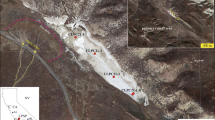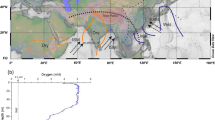Abstract
Reader Lake and Elbow Lake, two high-altitude lakes in the Uinta Mountains of Utah, are located approximately 2 km apart, at similar elevations, and within identical vegetation communities. Loss on ignition, carbon to nitrogen ratios, biogenic silica, and sediment grain size were analyzed throughout percussion cores retrieved from both lakes to construct continuous time series spanning 14 to ca. 2 ka BP. Given the proximity of the lakes, it is assumed that both were subjected to the same climatic forcing over this time. Accordingly, the first goal of this study was to consider these two multiproxy datasets in concert to yield an integrated paleoclimate record for this region. Close inspection of the records identified discrepancies indicating that the lakes responded to climate changes in different ways despite their proximity and similar setting. Clarifying these differences and understanding why the two lakes behaved differently at certain times was the second goal of this study. Overall, the paleoclimatic records document lake formation in the latest Pleistocene following glacier retreat. Buried glacier ice at the location of Reader Lake may have persisted through the Younger Dryas. Both lakes became biologically productive ca. 11.5 ka BP, and the first appearance of conifer needles indicates that trees had replaced alpine tundra in these watersheds by 10.5 ka BP. The interval from 10 to 6 ka BP was marked by a dramatic increase in precipitation, perhaps related to enhanced monsoonal circulation driven by the insolation maximum. The two lakes recorded this event in notably contrasting ways given their differing hydrogeomorphic settings. Precipitation decreased from 6 to 4 ka BP, and low water levels and drought conditions marked the interval from 4.0 to 2.7 ka BP. The integrated paleoclimate record developed from these cores provides a useful point of comparison with other records from the region. The differences between the records from these closely spaced lakes underscore the need to consider hydrogeomorphic setting when evaluating the suitability of a lake for a paleolimnological study.



Similar content being viewed by others
References
Berger A (1978) Long-term variations of caloric insolation resulting from earth’s orbital elements. Quat Res 9:139–167
Blass A, Bigler C, Grosjean M, Sturm M (2007) Decadal-scale autumn temperature reconstructions back to AD 1580 inferred from varved sediments of Lake Silvaplana (southeastern Swiss Alps). Quat Res 68:184–195
Booth RK, Jackson ST, Forman SL, Kutzbach JE, Bettis EA, Kreig J, Wright DK (2005) A severe centennial-scale drought in mid-continental North America 4200 years ago and apparent global linkages. Holocene 15:321–328
Bradbury JP, Bezrukova YV, Chernyaeva GP, Colman SM, Khursevich G, King JW, Likoshway YV (1994) A synthesis of post-glacial diatom records from Lake Baikal. J Paleolimnol 10:213–252
Brown T, Nelson D, Mathewes R, Vogel J, Southon J (1989) Radiocarbon dating of pollen by accelerator mass spectrometry. Quat Res 32:205–212
Brown S, Bierman PR, Lini A, Southon J (2000) 10,000 year record of extreme hydrologic events. Geology 28:335–338
Brunelle A, Anderson RS (2003) Sedimentary charcoal as an indicator of late-holocene drought in the Sierra Nevada, California, and its relevance to the future. Holocene 13:21–28
Chu G, Liu J, Sun Q, Lu H, Gu Z, Wang W, Liu T (2002) The ‘mediaeval warm period’ drought recorded in Lake Huguangyan, tropical South China. Holocene 12:511–516
Dean WE (1974) Determination of carbonate and organic matter in calcareous sediments and sedimentary rocks by loss on ignition: comparison with other methods. J Sediment Petrol 44:242–248
Dean WE, Forester RM, Bradbury JP (2002) Early Holocene change in atmospheric circulation in the Northern Hemisphere Great Plains: an upstream view of the 8.2 ka cold event. Quat Sci Rev 21:1763–1775
Dehler CM, Sprinkel DA (2005) Revised stratigraphy and correlation of the Neoproterozoic Uinta Mountain Group, northeastern Utah. In: Dehler CM, Pederson JL, Sprinkel DA, Kowallis BJ (eds) Uinta mountain geology. Utah Geological Association Publication 33, Salt Lake City, pp 17–30
DeMaster DJ (1981) The supply and accumulation of silica in the marine environment. Geochim Cosmochim Acta 45:1715–1732
Dunn SM, Mackay R (1995) Spatial variation in evapotranspiration and the influence of land use of catchment hydrology. J Hydrol 171:49–73
Fall PL, Davis PT, Zielinski GA (1995) Late quaternary vegetation and climate of the Wind River Range, Wyoming. Quat Res 43:393–404
Feiler EJ, Anderson RS, Koehler A (1997) Late quaternary paleoenvironments of the White River Plateau, Colorado. USA Arct Alp Res 29:53–62
Forman SL, Oglesby R, Markgraf A, Stafford T (1995) Paleoclimatic significance of late quaternary eolian deposition on the piedmont and high plains, central United States. Glob Planet Change 11:35–55
Ji S, Xingqi L, Sumin W, Matsumoto R (2005) Paleoclimatic changes in the Qinghai Lake area during the last 18,000 years. Quat Int 136:131–140
Laabs BJC, Refsnider KA, Munroe JS, Mickelson DM, Applegate PJ, Singer BS, Caffee MW (2009) Latest pleistocene glacial chronology of the Uinta Mountains: support for moisture-driven asynchrony of the last deglaciation. Quat Sci Rev 28:1171–1187
Mayewski PA, Rohling EE, Stager JC, Karlen W, Maasch KA, Meeker LD, Meyerson EA, Gasse F, Kreveld S, Holmgren K, Lee-Thorp J, Rosqvist G, Rack F, Staubwasser M, Schneider RR, Steig E (2004) Holocene climate variability. Quat Res 62:243–255
Mensing SA, Benson LV, Kashgarian M, Lund S (2004) A Holocene pollen record of persistent droughts from Pyramid Lake, Nevada, USA. Quat Res 62:29–38
Meyers PA, Ishiwatari R (1993) Lacustrine organic geochemistry—an overview of indicators of organic matter sources and diagenesis in lake sediment. Org Geochem 20:867–900
Moser KA, Kimball JP (2009) A 19,000-year record of hydrologic and climatic change inferred from diatoms from Bear Lake, Utah and Idaho. In: Rosenbaum JG and Kaufman DS (eds) Paleoenvironments of Bear Lake, Utah and Idaho, and its catchment. Geological Society of America Special Paper 450, pp 229–246
Mucciarone DA (2003) Stanford university stable isotope laboratory online manual. Section 6A: Biogenic silica. Available online at: http://pangea.stanford.edu/research/isotope/dam/pdf/Stanford_SIL_Online_manual.pdf
Munroe JS (2002) Timing of postglacial cirque reoccupation in the northern Uinta Mountains, northeastern Utah, USA. Arct Antarct Alp Res 34:38–48
Munroe JS (2003) Holocene timberline and palaeoclimate of the Uinta Mountains, Utah. Holocene 13:175–185
Munroe JS (2007) Exploring relationships between watershed properties and Holocene loss-on-ignition records in high-elevation lakes, southern Uinta Mountains, Utah, USA. Arct Antarct Alp Res 39:556–565
Munroe JS, Mickelson DM (2002) Last glacial maximum equilibrium-line altitudes and paleoclimate, northern Uinta Mountains, Utah, USA. J Glaciol 48:257–266
Munroe JS, Laabs BJC, Shakun JD, Singer BS, Mickelson DM, Refsnider KA, Caffee MW (2006) Latest pleistocene advance of alpine glaciers in the southwestern Uinta Mountains, Utah, USA: evidence for the influence of local moisture sources. Geology 34:841–844
Noren AJ, Bierman PR, Steig EJ, Lini A, Southon J (2002) Millennial-scale storminess variability in the northeastern United States during the Holocene epoch. Nature 419:821–824
Paulsen T, Marshak S (1999) Origin of the Uinta recess, Sevier fold-thrust belt, Utah: influence of basin architecture on fold-thrust belt geometry. Tectonophysics 312:203–216
Peinerud EK, Ingri J, Pontér C (2001) Non-detrital Si concentrations as an estimate for diatom concentrations in lake sediments and suspended material. Chem Geol 177:229–239
Porinchu DF, MacDonald GM, Bloom AM, Moser KA (2003) Late pleistocene and early Holocene climate and limnological changes in the Sierra Nevada, California, USA, inferred from midges (Insecta: Diptera: Chironomidae). Palaeogeogr Palaeoecol 198:403–422
Prokopenko AA, Karabanov EB, Williams DF, Kuzmin MI, Shackleton NJ, Crohurst SJ, Peck JA, Gvozdkov AN, King JW (2001) Biogenic silica record of the Lake Baikal response to climate forcing during the Brunhes. Quat Res 55:123–132
Reasoner M (1993) Equipment and procedure improvements for a lightweight, inexpensive, percussion core sampling system. J Paleolimnol 8:273–281
Rubensdotter L, Rosqvist G (2003) The effect of geomorphological setting on Holocene lake sediment variability, northern Swedish Lapland. J Quat Sci 18:757–767
Rubensdotter L, Rosqvist G (2009) Influence of geomorphological setting, fluvial-, glaciofluvial-, and mass-movement processes on sedimentation in alpine lakes. Holocene 19:665–678
Sampei Y, Matsumoto E (2001) C/N ratios in a sediment core from Nakaumi Lagoon, southwest Japan—usefulness as an organic source indicator. Geochem J 35:189–205
Shuman B (2003) Controls on loss-on-ignition variation in cores from two shallow lakes in the northeastern United States. J Paleolimnol 30:371–385
Shuman B, Henderson AK, Colman SM, Stone JR, Fritz SC, Steven LR, Power MJ, Whitlock C (2009) Holocene lake-level trends in the Rocky Mountains. USA Quat Sci Rev 28:1861–1879
Stokes S, Gaylord DR (1993) Optical dating of Holocene dune sands in the ferris dune field, Wyoming. Quat Res 39:274–281
Stone JR, Fritz SC (2006) Multidecadal drought and Holocene climate instability in the Rocky Mountains. Geology 34:409–412
Taylor KC, Lamorey GW, Doyle GA, Alley RB, Grootes PM, Mayewski PA, White JWC, Barlow LK (1993) The ‘flickering switch’ of late pleistocene climate change. Nature 361:432–435
Thompson RS, Whitlock CW, Bartlein PJ, Harrison SP, Spaulding WG (1993) Climatic changes in the western United States since 18,000 years B.P. In: Wright HE, Kutzbach JE, Webb T, Ruddiman WF, Street-Perrot RA, Bartlein PJ (eds) Global climates since the last glacial maximum. University of Minnesota Press, Minneapolis, pp 514–535
Whitlock C, Bartlein PJ (1993) Spatial variations of Holocene climate change in the yellowstone region. Quaternary Res 39:231–238
Acknowledgments
Financial support for this project was provided by NSF-EAR 0345112 to Munroe, by the Ashley National Forest, and by the Middlebury College Senior Work Fellowship. Field and laboratory support was provided by M. Devito, N. Oprandy, B. Laabs, D. Munroe, C. Plunkett, C. Anderson, D. Berkman, B. Fisher, and C. Rodgers. J. Honke of the USGS assisted with preparing the pollen concentrates, and A. Lini of the University of Vermont assisted with C/N measurements.
Author information
Authors and Affiliations
Corresponding author
Rights and permissions
About this article
Cite this article
Corbett, L.B., Munroe, J.S. Investigating the influence of hydrogeomorphic setting on the response of lake sedimentation to climatic changes in the Uinta Mountains, Utah, USA. J Paleolimnol 44, 311–325 (2010). https://doi.org/10.1007/s10933-009-9405-9
Received:
Accepted:
Published:
Issue Date:
DOI: https://doi.org/10.1007/s10933-009-9405-9




